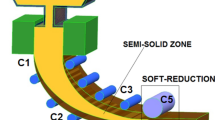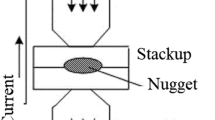Abstract
The wide application of welding manufacturing across key significant industries has aroused an increasing concern on weldments’ reliability. Weld residual stress, as a critical factor, is closely related to structural and material-level failures of weldments. Hence, the prediction of residual stress is necessary for ensuring weldments’ reliability. Neural network models have emerged as promising methods to achieve this prediction. In this review, the prediction of residual stress based on neural network models is reviewed to summarize current state and uncover their limitations. In terms of these limitations, this review gives substantial suggestions for future research on neural network modeling.


















Similar content being viewed by others
Explore related subjects
Discover the latest articles, news and stories from top researchers in related subjects.References
Withers PJ (2007) Residual stress and its role in failure. Rep Progr Phys 70:2211. https://doi.org/10.1088/0034-4885/70/12/R04
Wu C, Kim J-W (2018) Analysis of welding residual stress formation behavior during circumferential TIG welding of a pipe. Thin-Walled Struct 132:421–430. https://doi.org/10.1016/j.tws.2018.09.020
D’Alvise L, Chantzis D, Schoinochoritis B, Salonitis K (2015) Modelling of part distortion due to residual stresses relaxation: an aeronautical case study. Procedia Cirp 31:447–452. https://doi.org/10.1016/j.procir.2015.03.069
Ao S, Li C, Huang Y, Luo Z (2020) Determination of residual stress in resistance spot-welded joint by a novel X-ray diffraction. Measurement 161:107892. https://doi.org/10.1016/j.measurement.2020.107892
Kohandehghan AR, Serajzadeh S, Kokabi AH (2010) A study on residual stresses in gas tungsten arc welding of AA5251. Mater Manuf Processes 25:1242–1250. https://doi.org/10.1080/10426914.2010.481004
Prime MB (2000) Cross-sectional mapping of residual stresses by measuring the surface contour after a cut. J Eng Mater Technol 123:162–168. https://doi.org/10.1115/1.1345526
L.-E. Lindgren, ed., Computational Welding Mechanics: Thermomechanical and Microstructural Simulations, in: CRC Press, 2007. https://doi.org/10.1201/9781439824092.
Bishop CM (1995) Neural networks for pattern recognition. Oxford University Press. https://doi.org/10.1093/oso/9780198538493.001.0001
Hassoun MH, Intrator N, McKay S, Christian W (1996) Fundamentals of artificial neural networks. Comput Phys 10:137–137. https://doi.org/10.1063/1.4822376
Qiu X, Ren Y, Suganthan PN, Amaratunga GAJ (2017) Empirical mode decomposition based ensemble deep learning for load demand time series forecasting. Appl Soft Comput 54:246–255. https://doi.org/10.1016/j.asoc.2017.01.015
Wang H, Li G, Wang G, Peng J, Jiang H, Liu Y (2017) Deep learning based ensemble approach for probabilistic wind power forecasting. Appl Energy 188:56–70. https://doi.org/10.1016/j.apenergy.2016.11.111
Hinton GE, Salakhutdinov RR (2006) Reducing the dimensionality of data with neural networks. Science 313:504–507. https://doi.org/10.1126/science.1127647
Khoshroyan A, Darvazi AR (2020) Effects of welding parameters and welding sequence on residual stress and distortion in Al6061-T6 aluminum alloy for T-shaped welded joint. T Nonferr Metal Soc 30:76–89. https://doi.org/10.1016/S1003-6326(19)65181-2
Zhao L, Liang J, Zhong Q, Yang C, Sun B, Du J (2014) Numerical simulation on the effect of welding parameters on welding residual stresses in T92/S30432 dissimilar welded pipe. Adv Eng Software 68:70–79. https://doi.org/10.1016/j.advengsoft.2013.12.004
Sun J, Klassen J, Nitschke-Pagel T, Dilger K (2018) Effects of heat source geometric parameters and arc efficiency on welding temperature field, residual stress, and distortion in thin-plate full-penetration welds. Int J Adv Manuf Technol 99:497–515. https://doi.org/10.1007/s00170-018-2516-6
Farajkhah V, Liu Y (2017) Effect of clamping area and welding speed on the friction stir welding-induced residual stresses. Int J Adv Manuf Technol 90:339–348. https://doi.org/10.1007/s00170-016-9393-7
Mathew J, Griffin J, Alamaniotis M, Kanarachos S, Fitzpatrick ME (2018) Prediction of welding residual stresses using machine learning: Comparison between neural networks and neuro-fuzzy systems. Appl Soft Comput 70:131–146. https://doi.org/10.1016/j.asoc.2018.05.017
M. Riedmiller, H. Braun, 1993 A direct adaptive method for faster backpropagation learning: the RPROP algorithm, in: IEEE International Conference on Neural Networks. 1: 586–591. https://doi.org/10.1109/ICNN.1993.298623.
H. Yu, B.M. Wilamowski, Levenberg–Marquardt Training, Intelligent Systems. (2018). https://api.semanticscholar.org/CorpusID:240124461.
Edwin Raja Dhas J, Kumanan S (2016) Evolutionary fuzzy SVR modeling of weld residual stress. Appl Soft Comput 42:423–430. https://doi.org/10.1016/j.asoc.2016.01.050
Nagesh DS, Datta GL (2010) Genetic algorithm for optimization of welding variables for height to width ratio and application of ANN for prediction of bead geometry for TIG welding process. Appl Soft Comput 10:897–907. https://doi.org/10.1016/j.asoc.2009.10.007
Datta S, Pratihar DK, Bandyopadhyay PP (2012) Modeling of input–output relationships for a plasma spray coating process using soft computing tools. Appl Soft Comput 12:3356–3368. https://doi.org/10.1016/j.asoc.2012.07.015
Edwin Raja Dhas J, Kumanan S (2014) Neuro evolutionary model for weld residual stress prediction. Appl Soft Comput 14:461–468. https://doi.org/10.1016/j.asoc.2013.08.019
Shami TM, El-Saleh AA, Alswaitti M, Al-Tashi Q, Summakieh MA, Mirjalili S (2022) Particle swarm optimization: a comprehensive survey. IEEE Access 10:10031–10061. https://doi.org/10.1109/ACCESS.2022.3142859
Mathew J, Moat RJ, Paddea S, Fitzpatrick ME, Bouchard PJ (2017) Prediction of residual stresses in girth welded pipes using an artificial neural network approach. Int J Press Vessels Pip 150:89–95. https://doi.org/10.1016/j.ijpvp.2017.01.002
M.F. Møller, A Scaled Conjugate Gradient Algorithm for Fast Supervised Learning, in: 1990. https://api.semanticscholar.org/CorpusID:8029054.
Bouchard PJ (2007) Validated residual stress profiles for fracture assessments of stainless steel pipe girth welds. Int J Press Vessels Pip 84:195–222. https://doi.org/10.1016/j.ijpvp.2006.10.006
Ahmadzadeh M, Hoseini Fard A, Saranjam B, Salimi HR (2012) Prediction of residual stresses in gas arc welding by back propagation neural network. NDT E Int. 52:136–143. https://doi.org/10.1016/j.ndteint.2012.07.009
Rubio JDJ (2021) Stability analysis of the modified levenberg–marquardt algorithm for the artificial neural network training. IEEE Trans Neural Netw Learn Syst 32:3510–3524. https://doi.org/10.1109/TNNLS.2020.3015200
Na MG, Kim JW, Lim DH, Kang Y-J (2008) Residual stress prediction of dissimilar metals welding at NPPs using support vector regression. Nuclear Eng Design. 238:1503–1510. https://doi.org/10.1016/j.nucengdes.2007.12.003
Rissaki DK, Benardos PG, Vosniakos G-C, Smith MC, Vasileiou AN (2023) Residual stress prediction of arc welded austenitic pipes with artificial neural network ensemble using experimental data. Int J Press Vessels PipING 204:104954. https://doi.org/10.1016/j.ijpvp.2023.104954
Park J, An G, Ma N, Kim S-J (2023) Prediction of transverse welding residual stress considering transverse and bending constraints in butt welding. J Manuf Processes 102:182–194. https://doi.org/10.1016/j.jmapro.2023.07.043
Netrapalli P (2019) Stochastic gradient descent and its variants in machine learning. J Indian Inst Sci 99:201–213. https://doi.org/10.1007/s41745-019-0098-4
Liu F, Tao C, Dong Z, Jiang K, Zhou S, Zhang Z, Shen C (2021) Prediction of welding residual stress and deformation in electro-gas welding using artificial neural network. Materials Today Communications 29:102786. https://doi.org/10.1016/j.mtcomm.2021.102786
Whittington JCR, Bogacz R (2019) Theories of error back-propagation in the brain. Trends Cogn Sci 23:235–250. https://doi.org/10.1016/j.tics.2018.12.005
Cheng M, Jiao L, Yan P, Feng L, Qiu T, Wang X, Zhang B (2021) Prediction of surface residual stress in end milling with Gaussian process regression. Measurement 178:109333. https://doi.org/10.1016/j.measurement.2021.109333
Deringer VL, Bartók AP, Bernstein N, Wilkins DM, Ceriotti M, Csányi G (2021) Gaussian Process Regression for Materials and Molecules. Chem Rev 121:10073–10141. https://doi.org/10.1021/acs.chemrev.1c00022
Schonlau M, Zou RY (2020) The random forest algorithm for statistical learning. Stand Genomic Sci 20:3–29. https://doi.org/10.1177/1536867X20909688
Mathew J, Moat RJ, Paddea S, Francis JA, Fitzpatrick ME, Bouchard PJ (2017) Through-thickness residual stress profiles in austenitic stainless steel welds: a combined experimental and prediction study. Metallurgical Mater Trans A-Phys Metall Mater Sci 48A:6178–6191. https://doi.org/10.1007/s11661-017-4359-4
Zainal N, Zain AM, Radzi NHM, Othman MR (2016) Glowworm swarm optimization (GSO) for optimization of machining parameters. J Intell Manuf 27:797–804. https://doi.org/10.1007/s10845-014-0914-7
Wang L, Alexander CA (2015) Big data in design and manufacturing engineering. AJEAS 8:223–232. https://doi.org/10.3844/ajeassp.2015.223.232
Khan AUR, Othman M, Madani SA, Khan SU (2014) A survey of mobile cloud computing application models. IEEE Commun Surv Tutorials 16:393–413. https://doi.org/10.1109/SURV.2013.062613.00160
Assunção MD, Calheiros RN, Bianchi S, Netto MAS, Buyya R (2015) Big Data computing and clouds: trends and future directions. J Parallel Distrib Computing 79–80:3–15. https://doi.org/10.1016/j.jpdc.2014.08.003
Gandomi A, Haider M (2015) Beyond the hype: Big data concepts, methods, and analytics. Int J Inf Manage 35:137–144. https://doi.org/10.1016/j.ijinfomgt.2014.10.007
Mishra S, DebRoy T (2005) A heat-transfer and fluid-flow-based model to obtain a specific weld geometry using various combinations of welding variables. J Appl Phys 98:044902. https://doi.org/10.1063/1.2001153
Kumar A, DebRoy T (2004) Guaranteed fillet weld geometry from heat transfer model and multivariable optimization. Int J Heat Mass Transf 47:5793–5806. https://doi.org/10.1016/j.ijheatmasstransfer.2004.06.038
Rai R, DebRoy T (2006) Tailoring weld geometry during keyhole mode laser welding using a genetic algorithm and a heat transfer model. J Phys D: Appl Phys 39:1257–1266. https://doi.org/10.1088/0022-3727/39/6/037
Acknowledgements
All authors are grateful to Class III Peak Discipline of Shanghai—Materials Science and Engineering (High-Energy Beam Intelligent Processing and Green Manufacturing) for its support in conducting experimental measurements.
Author information
Authors and Affiliations
Contributions
Yuli Qin was involved in methodology, software, project administration, data curation, writing—original draft, validation, investigation, writing—original draft and software. Chunwei Ma contributed to material preparation, resources, supervision and project administration. Lin Mei took part in conceptualization, resources, supervision and validation.
Corresponding author
Ethics declarations
Conflict of interest
I, along with my coauthors, have no relevant financial or non-financial interests to disclose.
Additional information
Handling Editor: Scott Beckman.
Publisher's Note
Springer Nature remains neutral with regard to jurisdictional claims in published maps and institutional affiliations.
Rights and permissions
Springer Nature or its licensor (e.g. a society or other partner) holds exclusive rights to this article under a publishing agreement with the author(s) or other rightsholder(s); author self-archiving of the accepted manuscript version of this article is solely governed by the terms of such publishing agreement and applicable law.
About this article
Cite this article
Qin, Y., Ma, C. & Mei, L. Prediction of residual stresses in welded structures based on neural network: a review. J Mater Sci (2024). https://doi.org/10.1007/s10853-024-10178-6
Received:
Accepted:
Published:
DOI: https://doi.org/10.1007/s10853-024-10178-6




